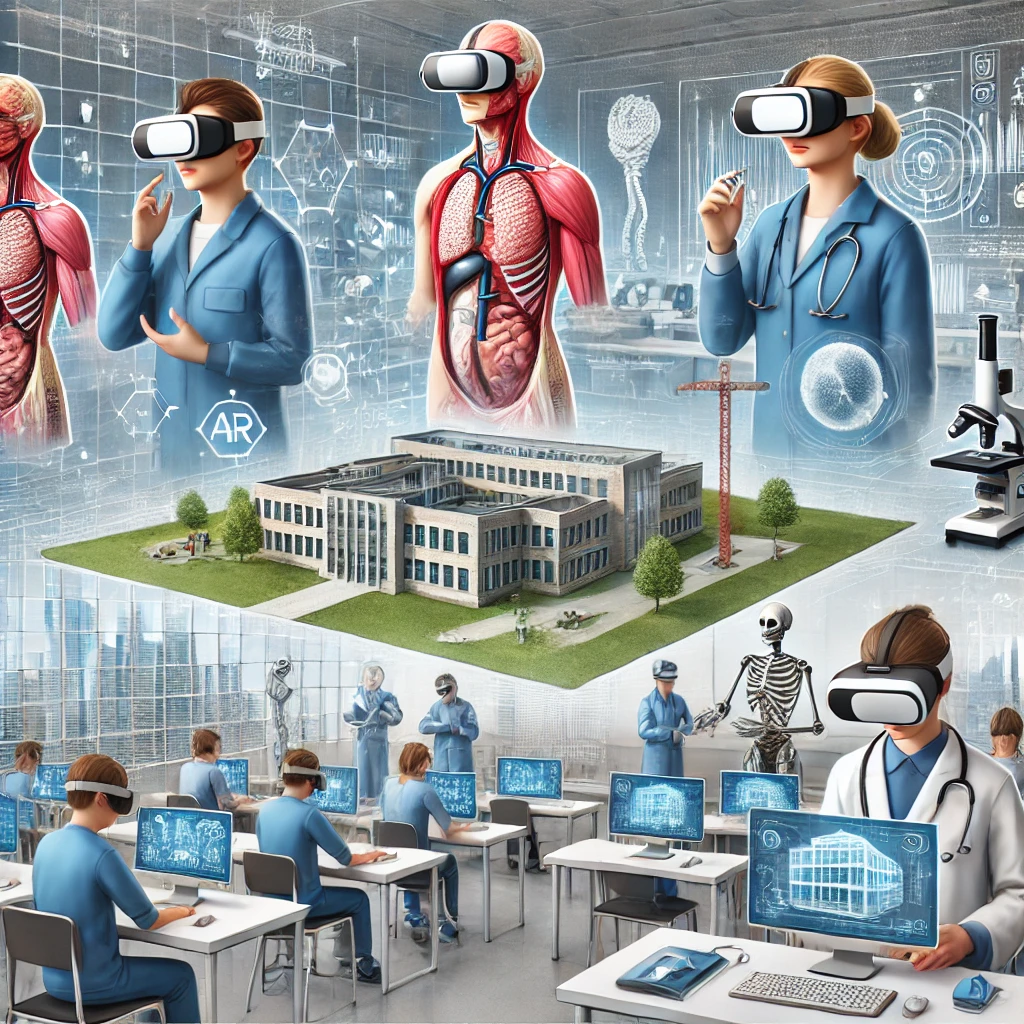Augmented Reality (AR) and Virtual Reality (VR) are revolutionizing learning and development, offering immersive environments that surpass traditional techniques. These innovations allow learners to engage with material in an interactive and practical way. From virtual excursions to hands-on practice in simulated settings, AR and VR are changing how we learn and prepare for real-life challenges.
This piece examines the impact of AR and VR on education and training, including their advantages, obstacles, and future possibilities.
1. Grasping AR and VR in Education
Augmented Reality (AR): AR integrates digital elements into the real world through devices like smartphones, tablets, or AR glasses. For example, students can see a 3D model of a human heart during a biology class.
Virtual Reality (VR): VR constructs a completely digital environment that users explore with VR headsets. This technology allows learners to engage with simulated worlds, such as conducting virtual science experiments or flying an aircraft in a simulated cockpit.
Both AR and VR offer unique opportunities for hands-on and interactive learning.
2. Advantages of AR and VR in Education and Training
A. Increased Engagement and Memory Retention
Immersive Learning: AR and VR make lessons more captivating, enabling students to interact with content instead of just observing.
Better Retention: Research indicates that interactive and immersive learning improves memory retention compared to conventional methods.
B. Safe Learning Environments
Risk-Free Practice: VR allows trainees to practice high-risk tasks, like performing surgeries or operating heavy machinery, in a controlled setting with no real-world risks.
Learning from Mistakes: Learners can make errors and learn from them without real-life consequences.
C. Access to Resources
Global Reach: Students can virtually visit historical sites, explore distant planets, or join workshops, overcoming geographical limits.
Personalized Learning: AR and VR can be tailored to individual learning speeds and preferences, catering to diverse needs.
D. Bridging Theory and Practice
Practical Application: Simulations enable learners to apply theoretical knowledge in practical settings, boosting understanding and confidence.
3. Uses of AR and VR in Education and Training
A. In the Classroom
STEM Learning: AR apps like Google Expeditions and VR platforms like Labster let students explore 3D models, conduct virtual experiments, or simulate space missions.
Language Learning: Immersive environments allow students to practice new languages in realistic settings, like a virtual Parisian café.
B. Vocational Training
Medical Training: VR helps medical students perform virtual surgeries, refining their skills before working with real patients.
Engineering and Construction: Trainees can practice operating machinery or designing structures with AR and VR tools.
C. Corporate Training
Employee Onboarding: Companies such as Walmart and UPS use VR simulations for onboarding, helping new hires get familiar with roles and environments.
Soft Skills Development: VR provides scenarios for practicing public speaking, negotiation, or customer service interactions.
D. Military and Defense
Combat Training: VR offers realistic combat scenarios, preparing soldiers for missions.
Crisis Management: Simulations train disaster response teams to handle emergencies efficiently.
4. Challenges of AR and VR in Education and Training
A. High Costs
Hardware Expenses: VR headsets and AR-enabled devices can be costly for institutions with tight budgets.
Development Costs: Creating high-quality, customized AR and VR content involves significant investment. Accessibility Issues
Digital Divide
Not everyone has the tech or internet needed for effective use.
Learning Curve
Teachers and trainers might need extra training to use these new tools well.
Technical Limitations
Hardware Limitations
Heavy VR headsets and short battery life can limit usage time.
Software Compatibility
AR and VR apps need to work on various devices and platforms.
Health Concerns
Motion Sickness
Using VR for too long can make some people feel sick.
Eye Strain
Too much screen time can cause eye fatigue.
The Future of AR and VR in Education
Advancements in Technology
Lighter and Cheaper Devices
As tech improves, AR and VR gear will become more affordable and easier to use.
AI Integration
Combining AR/VR with AI will create smarter learning systems.
Mainstream Adoption
Increased Accessibility
Lower costs will help more schools and organizations use AR and VR.
Government Support
Governments might fund programs to bring these technologies into public education.
New Learning Paradigms
Metaverse Education
Virtual campuses could offer global, collaborative learning experiences.
Lifelong Learning
AR and VR will help adults learn new skills at any age.
Success Stories of AR and VR in Education
Stanford University
Uses VR to teach complex subjects like molecular biology and climate change.
Walmart
Trained over a million employees with VR to improve service and operations.
Anatomy 3D Atlas
A popular AR tool that helps medical students explore 3D models of human anatomy.
These examples show how AR and VR can transform learning in different areas.
Practical Tips for Implementing AR and VR
Start Small
Begin with affordable AR apps or VR headsets before expanding.
Focus on Content
Invest in high-quality content that meets learners’ needs.
Provide Training
Ensure instructors know how to use AR and VR tools effectively.
Monitor Engagement
Regularly check how students or trainees use and benefit from the technology.
Conclusion
AR and VR are changing education and training by offering immersive and engaging experiences. While there are still challenges like cost and access, ongoing tech improvements and wider use suggest a future where AR and VR are key to learning and training.
As these technologies advance, they will help educators, trainers, and learners connect theory and practice, preparing people for the modern world. In classrooms, businesses, or military settings, AR and VR are shaping the future of education and training.
